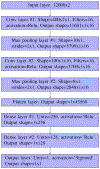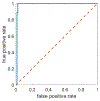Autoregulatory Efficiency Assessment in Kidneys Using Deep Learning
- PMID: 38288370
- PMCID: PMC10824283
- DOI: 10.23919/eusipco47968.2020.9287447
Autoregulatory Efficiency Assessment in Kidneys Using Deep Learning
Abstract
A convolutional deep neural network is employed to assess renal autoregulation using time series of arterial blood pressure and blood flow rate measurements in conscious rats. The network is trained using representative data samples from rats with intact autoregulation and rats whose autoregulation is impaired by the calcium channel blocker amlodipine. Network performance is evaluated using test data of the types used for training, but also with data from other models for autoregulatory impairment, including different calcium channel blockers and also renal mass reduction. The network is shown to provide effective classification for impairments from calcium channel blockers. However, the assessment of autoregulation when impaired by renal mass reduction was not as clear, evidencing a different signature in the hemodynamic data for that impairment model. When calcium channel blockers were given to those animals, however, the classification again was effective.
Keywords: biomedical signal processing; machine learning; nephrology; neural networks; physiology.
Figures







Similar articles
-
BP Fluctuations and the Real-Time Dynamics of Renal Blood Flow Responses in Conscious Rats.J Am Soc Nephrol. 2020 Feb;31(2):324-336. doi: 10.1681/ASN.2019070718. Epub 2019 Dec 2. J Am Soc Nephrol. 2020. PMID: 31792155 Free PMC article.
-
Low protein diet mediated renoprotection in remnant kidneys: Renal autoregulatory versus hypertrophic mechanisms.Kidney Int. 2003 Feb;63(2):607-16. doi: 10.1046/j.1523-1755.2003.00759.x. Kidney Int. 2003. PMID: 12631125
-
Effect of nitrendipine on autoregulation of perfusion in the cortex and papilla of kidneys from Wistar and stroke prone spontaneously hypertensive rats.Br J Pharmacol. 1994 Jan;111(1):111-6. doi: 10.1111/j.1476-5381.1994.tb14031.x. Br J Pharmacol. 1994. PMID: 8012687 Free PMC article.
-
[Treatment of hypertension in renal parenchymal diseases].Tidsskr Nor Laegeforen. 1996 Jun 30;116(17):2022-6. Tidsskr Nor Laegeforen. 1996. PMID: 8766645 Review. Norwegian.
-
Assessment of renal autoregulation.Am J Physiol Renal Physiol. 2007 Apr;292(4):F1105-23. doi: 10.1152/ajprenal.00194.2006. Epub 2007 Jan 16. Am J Physiol Renal Physiol. 2007. PMID: 17229679 Review.
Cited by
-
Efficacy of Dynamics-based Features for Machine Learning Classification of Renal Hemodynamics.Proc Eur Signal Process Conf EUSIPCO. 2023 Sep;2023:1145-1149. doi: 10.23919/eusipco58844.2023.10289999. Epub 2023 Nov 1. Proc Eur Signal Process Conf EUSIPCO. 2023. PMID: 38162557 Free PMC article.
References
-
- Rossing P, Hommel E, Smidt UM, and Parving HH, “Impact of arterial blood pressure and albuminuria on the progression of diabetic nephropathy in IDDM patients,” Diabetes, vol. 42, pp. 715–719, 1993. - PubMed
-
- Bidani AK and Griffin KA, “Pathophysiology of hypertensive renal damage: implications for therapy,” Hypertension, vol. 44, pp. 595–601, 2004. - PubMed
Grants and funding
LinkOut - more resources
Full Text Sources
